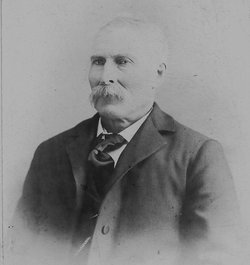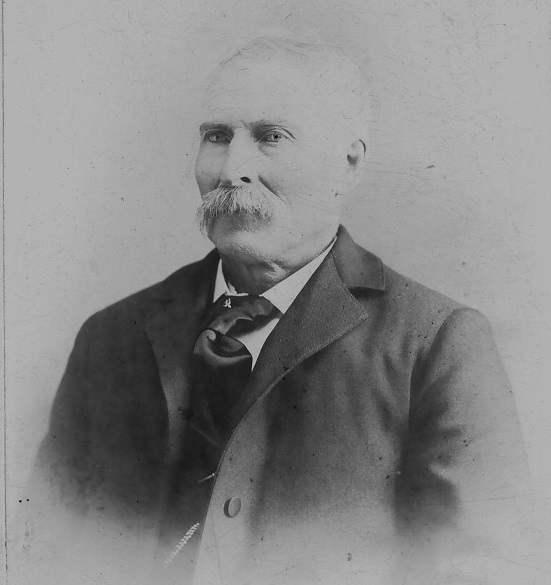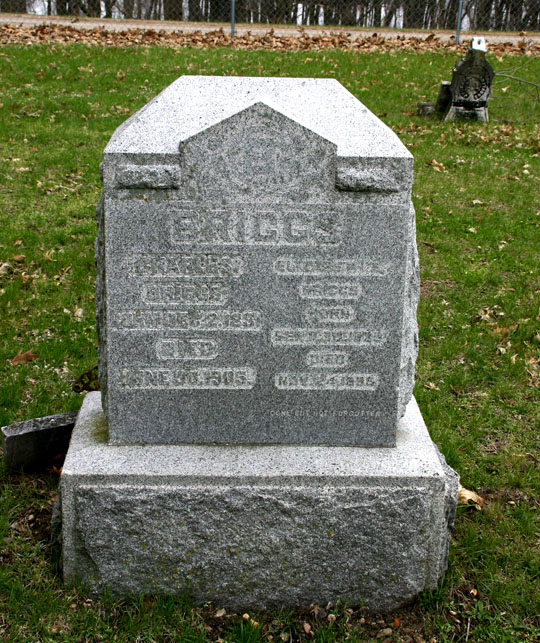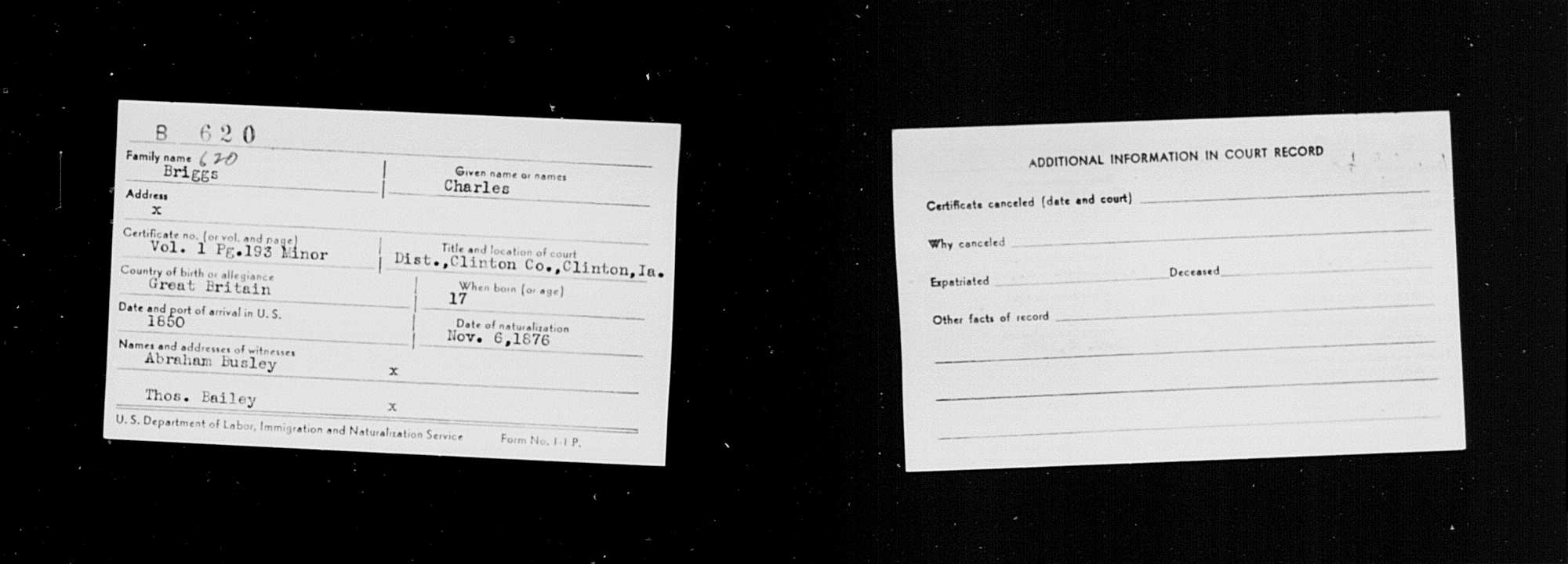Obituary of Charles Briggs Jr., by his brother-in-law, William Royal Oake . . .
Charles Briggs, the subject of this sketch, was born in the Village of Dullingham Lay, Cambridgeshire, England on the 2nd day of December 1831, and when in his 20th year, with his father, his mother having died a few years prior, embarked for America, and after an eventful voyage of over 13 weeks landed in New York City, from which place they came direct to Sabula, Iowa. A rather singular and suspicious incident was the wrecking of the vessel, which they sailed from England in. While sailing to the mainland in the Bahaman Islands on a beautiful Sunday morning, with the sea perfectly smooth, the ship at about 10 o'clock A.M. ran hard and fast upon a reef that are quite numerous in that locality. I have frequently heard the deceased say that it was plainly to be seen from the color of the water, that they were in close proximity to one of the numerous reefs that abound in these waters and it was the general opinion of all on board that the captain had deliberately run his ship upon the rock with the intention of wrecking it as it was getting old and was heavily insured. As the vessel began to sink its' sheeting started to float from the bottom, the rest lying on the rock, although in a precarious condition. There was no fear of its' immediate destruction in that calm sea.
The deceased said it was amusing to see and study the various sides of human nature. While some of the passengers would be weeping, others would be praying, and some cursing at their lamentable condition, while others would be eating their best grub, claiming that if they had to go down to the bottom, it would be on a full stomach. In the afternoon, the deceased being the first man on board to discover it, a small speck was seen in the distant horizon which gradually grew larger and larger, and which proved to be a wrecking vessel from the Nassau Mainland, which removed passengers and crew and took them to that city.
They remained at Nassau a few weeks receiving the best of treatment from the natives and foreign residents. The writer has had many interesting talks with the deceased in regard to the habits and customs of the residents of the islands who were willing to do all in their power to make their stay as pleasant as possible, allowing them unlimited freedom in picking delicious oranges as they hung ripe on the trees.
Having been furnished another ship they again set sail to New York, and one day out, a terrific storm commenced which carried one of the mates of the vessel by the board and it seemed they were doomed for the bottom of the Atlantic, but the ship eventually reached the Port of New York in safety, from which city they came direct to Sabula in the Summer of 1851.
It is unnecessary for the writer to eulogize or dwell upon the character of the deceased. His life has been an open book to all especially the older residents of Sabula. It is enough to say "Charley" Briggs was the friend of every man, woman and child in this community, and I venture the assertion without fear of contradiction, that every one with whom he was acquainted with was a friend of "Uncle Charley".
While perhaps viewed from an orthodox standpoint, he was not a member of any particular church or creed. Few there are that came doing unto others, as you would wish them to do to you, as did Charles Briggs. Who could say but what this world is better by much today by such a man having lived in it, assisting by his moral influence, the future of the rising generation.
On the 22nd day of October 1857, the deceased was married to Elizabeth Oake, and from that union sprang ten children, two having died when quite young, many years ago. His partner in life's journey preceded him in that mysterious future on the 24th of November 1895. Mary, the eldest daughter followed her mother on March 27th, 1896, who in turn was followed by the youngest son, Luther who died December 6, 1897, Alma, the youngest daughter dying January 10, 1905. Thus it will be seen that the grim messenger has claimed five of the family within ten years.
Five children remain to mourn the loss of a kind father and an indulgent parent. Edward, Charles, Fred, George and Agnes, all having the sympathy of the entire community which they have lived, and who should bear in mind that although Father is gone, they have the consolation of knowing that Father's life was without a stain and the recollection of this fact should stimulate them to edify his life and character. Bearing in mind this fact that Father cannot live forever and even bearing in mind his young will sometime go to him.
Besides his own immediate family, the deceased leaves one full sister, Mrs. Luther Seeber, Sabula and two half sisters, Mrs. Alice Stevens of Nashua, Iowa and Mrs. John Sparks of State Center, Iowa.
The funeral sermon was preached by Rev. J.J. Kidder at his son Fred's home at 2 P.M. and was attended by a large concourse of sympathizing friends, which was evidenced by the beautiful flower display that covered the casket and the large attendance that followed him to his last house at Evergreen Cemetery.
_________________________________________________________
Excerpts from History of Jackson County, Iowa v.1, REMINISCENCES. By W. R. Oake.
Page 544: In those days there were more oxen used than horses. A yoke of well broken oxen were worth one hundred dollars, and while some of the young steers were easily broken, others were wild and it required patience and time to subdue them. One instance in particular I now recall. The late Chas. Briggs, his father, who will be remembered by the older residents of our city, and John and James Elsden, two young men who came from England with the Briggs' in 1851, bought a pair of wild and unbroken steers of the late James McCabe and taking a yoke with them one day, went out to the McCabe place with the intention of catching and yoking them up. Driving them into a yard they finally got ropes on them and succeeded in putting yokes on. At that time all south and east of the McCabe place for half a mile was dense thickets of plum, crab apple and other trees and almost impenetrable. After getting the yoke on the steers they opened the gate and let them out, thinking that they could hold them by the long rope tied round their horns. No sooner were the steers out than they gave a lunge and got away from the boys and made for the timber, and strange it may appear, they hunted for days and were unable to find them and finally gave it up. About ten days after this occurred, on going out to his bam, Mr. McCabe discovered one of the steers drinking at a drinking place near the bam and from the emaciated condition of the animal it was evident that it was almost starved and had but recently released itself from the yoke. McCabe at once sent word to the boys in town who came out at once and renewed the search for the other steer and about a week later found it, dead. It appears that in running through the thick brush the ropes became twisted around some trees and held them fast and had the key of the yoke not dropped and released one, both would have shared the same fate. The dead one had eaten all the brush in its reach before it succumbed to starvation.
Page 547: During the Summer of 1853, Charles Briggs Sr, and his son, the late Charles Briggs (Jr.), and the two Elsdons, mentioned before, had rented and were keeping bachelors' hall on the Deacon Esmay farm, now owned by Cornelius Peters. One day Chas. Briggs, Jr., was visiting at our log cabin and toward evening started home, carrying with him father's single barreled shotgun, one he had brought from England with him, and which at that time was, I believe, the best shotgun in Sabula. As Charley was going along the road toward home, he heard a rustling in the corn field just over the fence, on the west side of the road. Turning to see what caused it, he discovered a fine deer eating corn, not more than twenty feet from where he stood. The deer was looking directly at him, and, quickly raising his gun, he fired directly at its head. Did he kill the deer? Not much. Giving its head a shake it bounded away. Had he known then what he learned later, that it was impossible to kill a deer with a shotgun and small shot by firing directly at its face, but had shot directly at its breast, he would have killed the deer. Right here I would state for the benefit of all young nimrods when hunting deer with a shotgun, never shoot directly at its face, as they have a very thick skull and it requires a very good rifle to bring them down when shot directly in the face. The old shotgun spoken of, and which is now in my possession, has been in the family over seventy years, and I don't think there is a gun in Sabula that has killed more game in its time than that gun. When a boy of ten years, I frequently went with the late Charles Briggs hunting ducks on the island above town. Charley would shoot them and I carried them. When my load got too heavy, I would tie a string to them and hang them to a limb of a tree till we finished our hunt, intending to take them when we returned home. As a general thing, whenever we returned we would have more than we could carry, consequently would have ducks hanging on a half dozen trees on this island. We seldom returned to get them, so they would hang and rot. In those days you could gauge a hunters' bag of game only by the amount of ammunition he had with him, for he could kill as many as he wanted to.
___________________________________________________________________
Charles was christened on 10 Jan 1832, in Dullingham Ley, Cambridgeshire, England.
Charles was married on 27 Oct 1856 to Eliza E., by E. M. Westbrook, Justice of Peace.
Marriage record from History of Jackson County Iowa, Vol. II (1910), p 611.
Charles Briggs Jr. became a U.S. citizen on 6 Nov 1876.
____________________________________________________________
Other children whose internments are unknown:
Alma L.: b 4 Dec 1878; d 10 Jan 1905; married 2 Aug 1901 in Sabula, Iowa to:
+ William Helm (b ca 1871 in Redford, KY)
____________________________________________________________
Other siblings whose internments are unknown:
Edward: christened 15 Jun 1834; d unknown
Henry: christened 24 Mar 1837; d 17 Aug 1844/England
Thomas: christened 8 Mar 1840; d 20 Aug 1844/England
Biography compilation by 2X great grandson, Mark Hayden.
Obituary of Charles Briggs Jr., by his brother-in-law, William Royal Oake . . .
Charles Briggs, the subject of this sketch, was born in the Village of Dullingham Lay, Cambridgeshire, England on the 2nd day of December 1831, and when in his 20th year, with his father, his mother having died a few years prior, embarked for America, and after an eventful voyage of over 13 weeks landed in New York City, from which place they came direct to Sabula, Iowa. A rather singular and suspicious incident was the wrecking of the vessel, which they sailed from England in. While sailing to the mainland in the Bahaman Islands on a beautiful Sunday morning, with the sea perfectly smooth, the ship at about 10 o'clock A.M. ran hard and fast upon a reef that are quite numerous in that locality. I have frequently heard the deceased say that it was plainly to be seen from the color of the water, that they were in close proximity to one of the numerous reefs that abound in these waters and it was the general opinion of all on board that the captain had deliberately run his ship upon the rock with the intention of wrecking it as it was getting old and was heavily insured. As the vessel began to sink its' sheeting started to float from the bottom, the rest lying on the rock, although in a precarious condition. There was no fear of its' immediate destruction in that calm sea.
The deceased said it was amusing to see and study the various sides of human nature. While some of the passengers would be weeping, others would be praying, and some cursing at their lamentable condition, while others would be eating their best grub, claiming that if they had to go down to the bottom, it would be on a full stomach. In the afternoon, the deceased being the first man on board to discover it, a small speck was seen in the distant horizon which gradually grew larger and larger, and which proved to be a wrecking vessel from the Nassau Mainland, which removed passengers and crew and took them to that city.
They remained at Nassau a few weeks receiving the best of treatment from the natives and foreign residents. The writer has had many interesting talks with the deceased in regard to the habits and customs of the residents of the islands who were willing to do all in their power to make their stay as pleasant as possible, allowing them unlimited freedom in picking delicious oranges as they hung ripe on the trees.
Having been furnished another ship they again set sail to New York, and one day out, a terrific storm commenced which carried one of the mates of the vessel by the board and it seemed they were doomed for the bottom of the Atlantic, but the ship eventually reached the Port of New York in safety, from which city they came direct to Sabula in the Summer of 1851.
It is unnecessary for the writer to eulogize or dwell upon the character of the deceased. His life has been an open book to all especially the older residents of Sabula. It is enough to say "Charley" Briggs was the friend of every man, woman and child in this community, and I venture the assertion without fear of contradiction, that every one with whom he was acquainted with was a friend of "Uncle Charley".
While perhaps viewed from an orthodox standpoint, he was not a member of any particular church or creed. Few there are that came doing unto others, as you would wish them to do to you, as did Charles Briggs. Who could say but what this world is better by much today by such a man having lived in it, assisting by his moral influence, the future of the rising generation.
On the 22nd day of October 1857, the deceased was married to Elizabeth Oake, and from that union sprang ten children, two having died when quite young, many years ago. His partner in life's journey preceded him in that mysterious future on the 24th of November 1895. Mary, the eldest daughter followed her mother on March 27th, 1896, who in turn was followed by the youngest son, Luther who died December 6, 1897, Alma, the youngest daughter dying January 10, 1905. Thus it will be seen that the grim messenger has claimed five of the family within ten years.
Five children remain to mourn the loss of a kind father and an indulgent parent. Edward, Charles, Fred, George and Agnes, all having the sympathy of the entire community which they have lived, and who should bear in mind that although Father is gone, they have the consolation of knowing that Father's life was without a stain and the recollection of this fact should stimulate them to edify his life and character. Bearing in mind this fact that Father cannot live forever and even bearing in mind his young will sometime go to him.
Besides his own immediate family, the deceased leaves one full sister, Mrs. Luther Seeber, Sabula and two half sisters, Mrs. Alice Stevens of Nashua, Iowa and Mrs. John Sparks of State Center, Iowa.
The funeral sermon was preached by Rev. J.J. Kidder at his son Fred's home at 2 P.M. and was attended by a large concourse of sympathizing friends, which was evidenced by the beautiful flower display that covered the casket and the large attendance that followed him to his last house at Evergreen Cemetery.
_________________________________________________________
Excerpts from History of Jackson County, Iowa v.1, REMINISCENCES. By W. R. Oake.
Page 544: In those days there were more oxen used than horses. A yoke of well broken oxen were worth one hundred dollars, and while some of the young steers were easily broken, others were wild and it required patience and time to subdue them. One instance in particular I now recall. The late Chas. Briggs, his father, who will be remembered by the older residents of our city, and John and James Elsden, two young men who came from England with the Briggs' in 1851, bought a pair of wild and unbroken steers of the late James McCabe and taking a yoke with them one day, went out to the McCabe place with the intention of catching and yoking them up. Driving them into a yard they finally got ropes on them and succeeded in putting yokes on. At that time all south and east of the McCabe place for half a mile was dense thickets of plum, crab apple and other trees and almost impenetrable. After getting the yoke on the steers they opened the gate and let them out, thinking that they could hold them by the long rope tied round their horns. No sooner were the steers out than they gave a lunge and got away from the boys and made for the timber, and strange it may appear, they hunted for days and were unable to find them and finally gave it up. About ten days after this occurred, on going out to his bam, Mr. McCabe discovered one of the steers drinking at a drinking place near the bam and from the emaciated condition of the animal it was evident that it was almost starved and had but recently released itself from the yoke. McCabe at once sent word to the boys in town who came out at once and renewed the search for the other steer and about a week later found it, dead. It appears that in running through the thick brush the ropes became twisted around some trees and held them fast and had the key of the yoke not dropped and released one, both would have shared the same fate. The dead one had eaten all the brush in its reach before it succumbed to starvation.
Page 547: During the Summer of 1853, Charles Briggs Sr, and his son, the late Charles Briggs (Jr.), and the two Elsdons, mentioned before, had rented and were keeping bachelors' hall on the Deacon Esmay farm, now owned by Cornelius Peters. One day Chas. Briggs, Jr., was visiting at our log cabin and toward evening started home, carrying with him father's single barreled shotgun, one he had brought from England with him, and which at that time was, I believe, the best shotgun in Sabula. As Charley was going along the road toward home, he heard a rustling in the corn field just over the fence, on the west side of the road. Turning to see what caused it, he discovered a fine deer eating corn, not more than twenty feet from where he stood. The deer was looking directly at him, and, quickly raising his gun, he fired directly at its head. Did he kill the deer? Not much. Giving its head a shake it bounded away. Had he known then what he learned later, that it was impossible to kill a deer with a shotgun and small shot by firing directly at its face, but had shot directly at its breast, he would have killed the deer. Right here I would state for the benefit of all young nimrods when hunting deer with a shotgun, never shoot directly at its face, as they have a very thick skull and it requires a very good rifle to bring them down when shot directly in the face. The old shotgun spoken of, and which is now in my possession, has been in the family over seventy years, and I don't think there is a gun in Sabula that has killed more game in its time than that gun. When a boy of ten years, I frequently went with the late Charles Briggs hunting ducks on the island above town. Charley would shoot them and I carried them. When my load got too heavy, I would tie a string to them and hang them to a limb of a tree till we finished our hunt, intending to take them when we returned home. As a general thing, whenever we returned we would have more than we could carry, consequently would have ducks hanging on a half dozen trees on this island. We seldom returned to get them, so they would hang and rot. In those days you could gauge a hunters' bag of game only by the amount of ammunition he had with him, for he could kill as many as he wanted to.
___________________________________________________________________
Charles was christened on 10 Jan 1832, in Dullingham Ley, Cambridgeshire, England.
Charles was married on 27 Oct 1856 to Eliza E., by E. M. Westbrook, Justice of Peace.
Marriage record from History of Jackson County Iowa, Vol. II (1910), p 611.
Charles Briggs Jr. became a U.S. citizen on 6 Nov 1876.
____________________________________________________________
Other children whose internments are unknown:
Alma L.: b 4 Dec 1878; d 10 Jan 1905; married 2 Aug 1901 in Sabula, Iowa to:
+ William Helm (b ca 1871 in Redford, KY)
____________________________________________________________
Other siblings whose internments are unknown:
Edward: christened 15 Jun 1834; d unknown
Henry: christened 24 Mar 1837; d 17 Aug 1844/England
Thomas: christened 8 Mar 1840; d 20 Aug 1844/England
Biography compilation by 2X great grandson, Mark Hayden.

















